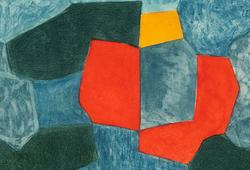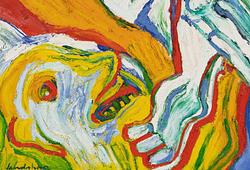Anders Zorn
The model Skald, academy janitor
Signed Zorn. Executed c. 1879 - 80. Oil on reinforced canvas 81 x 65 cm. Recorded in the Zorn Museum's archive as Manlig Modell (Male model), 1880. Skald went on to become janitor at Liljevalchs konsthall in Stockholm.
Provenance
Neumans Konsthandel, Stockholm (according to letter to Gerda Boëthius dated 26 November 1928)
Nils Wadin, Johanneshov (according to the Zorn Museum's archive, expertised by Gerda Boëthius in 1953).
Aktiebolaget Svensk Konstförmedling, Uppsala.
Office manager Helge Möller and Mrs. Hildur Möller, Helsingborg, aquired from the above according to a receipt dated 23 March 1964.
Private Collection.
Literature
Gerda Boëthius, "ZORN. Tecknaren. Målaren. Etsaren. Skulptören", 1949, possibly the painting mentioned p. 73 and listed in the catalog as Skalk, academy model, oil, under the year 1889 (ref. letter from Boëthius, dated 1953).
More information
Anders Zorn arrived in Stockholm in the autumn of 1875, at the age of eighteen, with good credentials as a woodcarver and figure draftsman. He was quickly admitted to the Royal Academy of Fine Arts' preparatory school, the Principskolan. During the five years of study, he lived as a lodger, which Albert Engström later depicted with both humour and warmth: "At the beginning of his stay in Stockholm, he had lodgings with a carpenter journeyman and his nasty wife. He managed to find new accommodation with a religious porter and got to socialise with other porters. Finally, he ended up in a kind postman's family."
During his early time in the capital, Zorn attended church and wrote home to his mother that he had heard Beskow preach at Adolf Fredrik's Church. At the same time, he began to partake in the city's social life – masquerades, balls, café societies at Berns and Blanche, and ice skating in Nybroviken were part of the young artist's everyday life.
In 1878, he completed his studies at the Principskolan and was admitted to the Royal Academy's higher education department. The following year, he graduated in perspective and anatomy – two subjects that would prove crucial in his artistic development.
The Academy's teaching at this time was characterised by classical idealism, technical precision, and a strict focus on the proportions and expressions of the human body.
The model study of the academy's janitor, Skald, is a clear example of how Zorn already distinguished himself as a young student. With his swift, confident brushstrokes and a characteristically limited colour palette, he managed not only to capture the model's outer form but also to convey an inner presence, a personal expression, and the subdued drama that rests in the model's posture and gaze.
The play of light over the subject and the rendering of textures and skin would later become one of Zorn's most distinguishing characteristics – particularly in his internationally acclaimed nude studies from the 1890s. Even in the study of Skald, we can sense what would become Zorn's greatness: the ability to unite technical brilliance with a profound human expression.
Artist
Anders Zorn, born in Mora in 1860, showed artistic talent from a young age. In 1875, he traveled to Stockholm and became a student at the then Slöjdskolan (now Tekniska högskolan) in Stockholm, and shortly after, he joined the Royal Academy of Fine Arts. Initially, Zorn had aspirations of becoming a sculptor, but soon watercolor painting took over, becoming his primary medium until 1887. At the student exhibition in 1880, Zorn had his breakthrough with the watercolor painting "I sorg." The following year, he gained international acclaim as a portrait painter. His watercolor painting reached its pinnacle during this period, and his most famous work from this time is "Vårt dagliga bröd” from 1886. Shortly thereafter, Zorn transitioned to oil painting, which was met with immediate success. Zorn's reputation mainly rested on his portrait art, and he portrayed many notable figures, including presidents. For instance, he created an etching of Theodore Roosevelt. His etchings significantly contributed to his success. In the late 1880s, Zorn began working in the genre that would increasingly become his trademark: nude figures in outdoor settings. He had long been fascinated by the movement of water and the reflections of light on its surface. Now, he added the complexity of placing a model near or in the water, aiming to depict a synthesis between nature and humanity. In 1896, Zorn and his wife moved back to Sweden and settled in Zorngården in Mora. This move sparked a renewed interest in his homeland, which would be reflected in his future paintings. Among the artist's scenes from the Mora region, portraying its local customs and ancient traditions, "Midsommardansen" holds the highest value according to Zorn himself. Today, the painting can be found at the National Museum.
Read more






























































